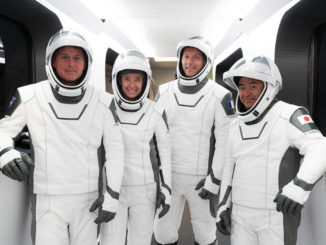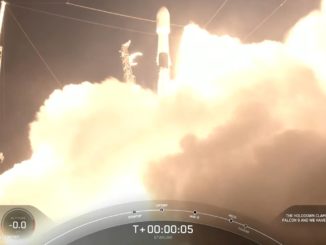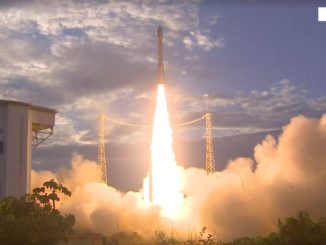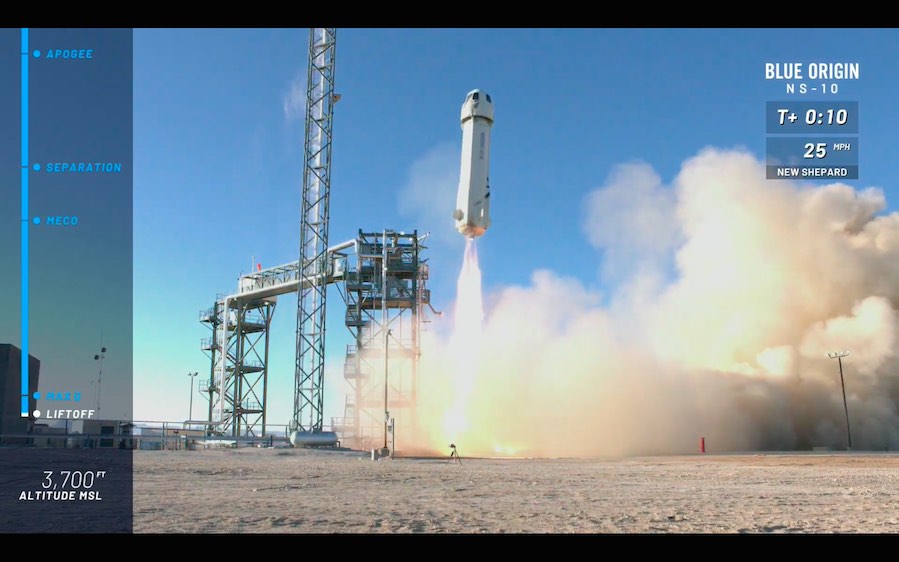
Blue Origin, the commercial space company founded by Amazon billionaire Jeff Bezos, launched a package of NASA experiments to the edge of space Wednesday from West Texas with a suborbital New Shepard booster, then successfully recovered the reusable rocket and space capsule a few minutes later.
The single stage rocket, powered by a BE-3 engine burning liquid hydrogen and liquid oxygen, took off at 10:05 a.m. EST (9:05 a.m. CST; 1505 GMT) from Blue Origin’s test site north of Van Horn, Texas, according to Ariane Cornell, a company sales director who anchored a video webcast of the mission.
After more than a month of delays caused by vehicle issues and bad weather, the New Shepard climbed to an altitude of more than 350,000 feet — nearly 107 kilometers — after firing the BE-3 engine for nearly two-and-a-half minutes. A capsule carrying the NASA research payloads separated from the New Shepard booster moments later, and the pair coasted toward apogee, the highest altitude of the mission, before descending back into the atmosphere.
The booster deployed air brakes to slow its descent, then reignited the BE-3 engine and extended landing legs to touch down on a landing pad around 2 miles (3 kilometers) from its launch location at the sprawling West Texas test site owned by Bezos.
A few minutes later, the capsule parachuted to a landing nearby to conclude the mission, which Blue Origin said lasted around 10 minutes, 15 seconds, from liftoff to capsule touchdown.

Wednesday’s launch was the 10th flight of Blue Origin’s New Shepard rocket, and the fourth launch and landing by the reusable propulsion module currently used by the company. The first New Shepard was lost in a landing accident in 2015, and the second unit has been retired.
A fourth New Shepard rocket, designed for human flights, is undergoing flight preps at Blue Origin’s facility in West Texas, officials said.
Blue Origin is taking a step-by-step approach to preparing for flights with passengers. The company’s target market for suborbital flights includes wealthy space tourists and working scientists.
Cornell said Blue Origin plans to be ready to carry humans to space by the end of this year.
“We’re aiming for the end of this year — by the end of this year — but as we said before, we’re not in a rush,” she said in the webcast of Wednesday’s launch. “We want to take our time. We want to do this right.
“As you know at Blue Origin, we take the conservative approach, we are patient, we want to build for you guys the safest and most reliable human flight system,” she said Wednesday.
“Believe me, if I could, I would jump on top of that rocket tomorrow,” Cornell said Jan. 8 at an aerospace industry conference. We’ve already had several successful tests with New Shepard, and so I would love to go. But we’re not selling tickets yet. We have not selected a price yet, despite what you might have read … We haven’t determined when we’re going to sell tickets. We are so focused right now on testing New Shepard through and through.”
Blue Origin’s main competitor in the suborbital space tourism market, Virgin Galactic founded by Richard Branson, has hundreds of would-be space fliers who have paid deposits on $250,000 tickets to ride aboard the SpaceShipTwo rocket plane.
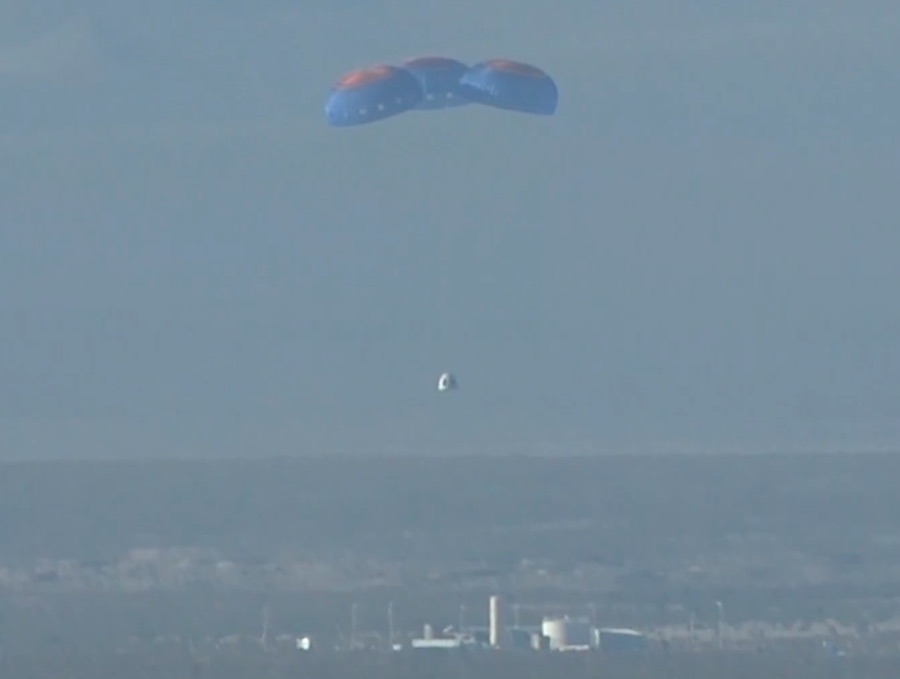
Wednesday marked Blue Origin’s first flight since July 18, when engineers demonstrated the vehicle’s high-altitude abort capability.
The capsule’s solid-fueled abort motor fired to quickly accelerate the craft away from the rocket, simulating the escape maneuver passengers would use to quickly get away from a failing booster at high altitude. Blue Origin accomplished a lower-altitude abort demonstration in 2016.
Cornell said Wednesday’s launch, designated New Shepard-10, followed a “nominal flight profile,” the same trajectory to be used for commercial research and space tourist flights.
On such flights, Cornell said passengers can expect to experience three or four minutes of weightlessness, along with spectacular views out of the capsule’s six windows, which Blue Origin says are the largest to have ever flown in space. Up to six passengers will fly on a single launch.
Virgin Galactic flew its air-dropped SpaceShipTwo rocket plane to the edge of space for the first time Dec. 13 with two test pilots at the controls.
The SpaceShipTwo rocket plane reached a maximum altitude of 51.4 miles, or 82.7 kilometers, on last month’s test flight, above the 50-mile mark used by the U.S. Air Force and the Federal Aviation Administration to determine who gets awarded astronaut wings. Blue Origin’s New Shepard flights reach the 100-kilometer (62-mile) Kármán line, the internationally-recognized boundary of space.
Last month’s SpaceShipTwo test flight was the first time a U.S. vehicle carrying people has flown above 50 miles since the last space shuttle mission in 2011.
Virgin Galactic plans to move SpaceShipTwo operations from a test site at the Mojave Air and Space Port in California to the new Spaceport America facility in New Mexico for regular commercial flights later this year.
Blue Origin earning revenue with launches carrying NASA payloads
Eight NASA-sponsored research experiments flew on Wednesday’s New Shepard launch, meaning Blue Origin is already earning some revenue as New Shepard test flights continue preparing for crewed flights.
The experiments include payloads from universities and NASA centers examining the behavior of a “green” non-toxic fuel in microgravity, demonstrating a way to measure fuel levels in microgravity using sound waves, testing technology to cool electronics in space, and measuring the naturally-occurring electromagnetic fields inside and outside the spacecraft.
Other NASA payloads include a pair of planetary science investigations from the University of Central Florida to help scientists better understand how dust particles on other planets might respond to human and robotic contact, and to evaluate the performance of an asteroid sample retrieval mechanism in a low-gravity environment.
New Shepard also carried to space Wednesday an experimental imager that could be used to support future biological investigations on suborbital rockets, and a vibration isolation platform to protect experiments from the shaking and forces encountered in flight.
“These NASA supported experiments will help advance in-space propulsion technologies, habitation systems, science instruments and other capabilities crucial for exploration,” said Jim Bridenstine, NASA’s administrator.
Email the author.
Follow Stephen Clark on Twitter: @StephenClark1.

